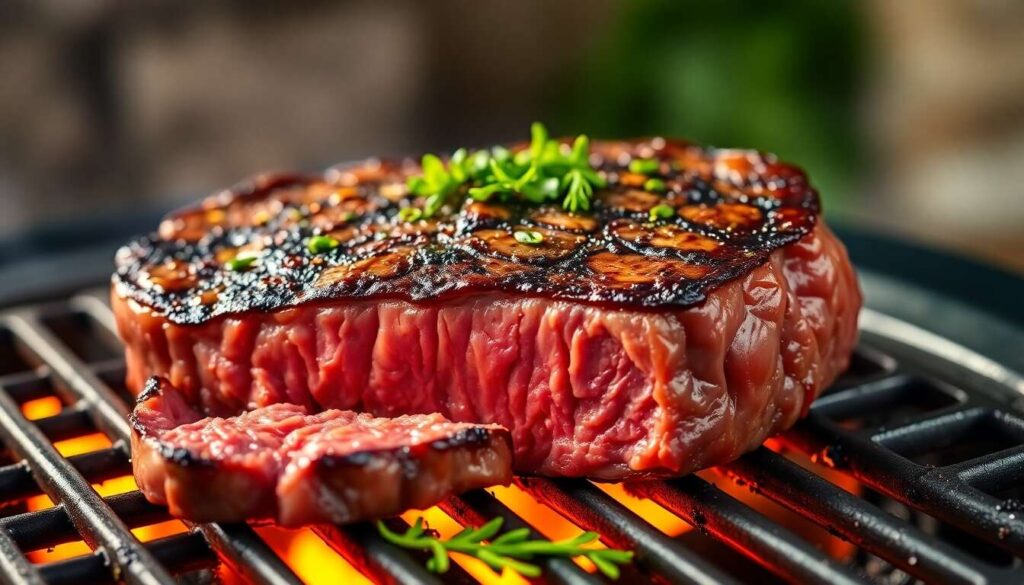Achieving the perfect steak is an art that requires both knowledge and practice. To prevent your meat from drying out while retaining its flavor and tenderness, several proven techniques, widely shared by professional chefs, can be applied.
Understanding Searing to Retain Juices in Your Steak
The Role of Searing in Juice Preservation
Searing a steak involves cooking the meat at high temperatures to create an outer crust. This crust plays a crucial role: it traps the juices inside the meat, helping to maintain its tenderness and flavor.
The Benefits of Quick Searing
Quick searing not only enhances the steak’s taste but also prevents dryness. It promotes even cooking and avoids excessive juice loss, ensuring the meat remains juicy and flavorful.
Once searing is mastered, it is essential to focus on properly preparing your meat before cooking.
Proper Preparation of the Meat Before Cooking
Bringing the Steak to Room Temperature
Before cooking, it is essential to take the steak out of the refrigerator to allow it to reach room temperature. It is recommended to let it rest for 30 minutes to an hour. This step ensures more even cooking and avoids significant thermal shock.
Eliminating Moisture from the Meat
For a beautiful sear, pat the steak dry with paper towels. Removing moisture allows for direct contact between the meat and heat, preventing steaming that could soften the surface.
With your steak well-prepared, the next step is to season the meat before searing.
The Importance of Seasoning Before Searing
Choosing the Right Seasoning
Seasoning the steak before searing is a critical step to enhance its flavor. Use freshly ground salt and pepper. Salt draws moisture from the surface, allowing for a better caramelization, while pepper adds a pleasant spicy note.
Applying Seasoning Evenly
Be sure to apply a uniform layer of seasoning all over the meat. This ensures consistent flavor in every bite. Don’t hesitate to gently massage the meat to help the spices penetrate.
Once the meat is seasoned, the cooking temperature becomes crucial to achieving perfection.
Mastering Temperature for Perfect Cooking
Understanding Cooking Temperatures
Mastering the temperature is essential for achieving the desired doneness. Here is a helpful guide:
| Degree of Doneness | Internal Temperature | Cooking Time |
|---|---|---|
| Rare | 55°C | 30 seconds per side |
| Medium | 60°C | 2 to 3 minutes on medium heat |
| Well Done | 70°C and above | 3 minutes on low heat |
Using a Cooking Thermometer
For precision, a cooking thermometer is an indispensable tool. It allows you to check the internal temperature of your steak in real-time.
With the temperature under control, we move on to the crucial step of flipping your steak.
Professional Tips for Flipping Your Steak
Using the Right Tools
To flip your steak without piercing it and losing juices, it is recommended to use tongs. This tool ensures precise and gentle handling of the meat.
When to Flip the Steak
- Check the sides of the steak: when they start to brown, it’s time to turn the meat.
- Flip the steak only once to avoid disrupting even cooking.
After searing and flipping, it is essential to let the steak rest to enhance tenderness.
Letting the Steak Rest: A Crucial Step
Why Is Resting Important?
Resting allows the juices to redistribute within the meat, ensuring a tender and flavorful texture in every bite. If you cut the meat too early, you risk ending up with a drier steak.
How Long to Allow to Rest?
It is advisable to let the steak rest for about 5 to 10 minutes. Place it on a rack or a warm, slightly covered plate to maintain the desired temperature without further cooking it.
Avoiding Common Mistakes That Can Dry Out the Meat
Using Excessive Heat for Too Long
Excessive heat can quickly dry out your steak. Opt for high-heat searing followed by low-heat cooking to preserve the meat’s tenderness.
Failing to Monitor Cooking
It is easy to inadvertently overcook the steak. Keep a vigilant eye on your pan and watch the time, or use a timer for better control.
By following these simple yet precise tips, you will avoid typical pitfalls and achieve a juicy, delicious steak every time.
To fully enjoy a good steak, it is crucial to focus on every step, from preparation to cooking to resting. By utilizing expert tips, such as using a cooking thermometer and respecting resting times, you can savor tender, flavorful, and perfectly cooked meat at every meal. Implement these techniques at your next dinner and rediscover the pleasure of a well-seared steak.







